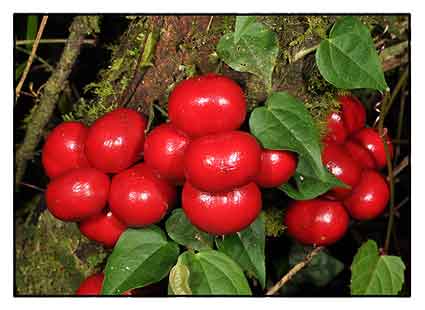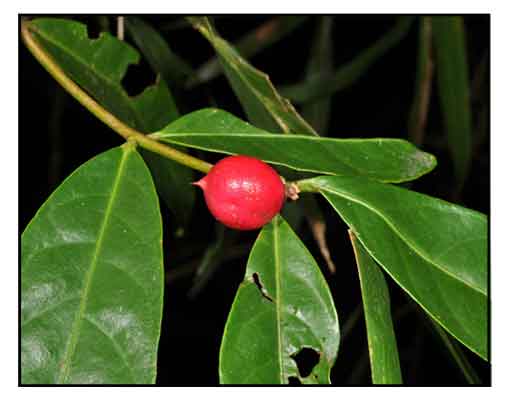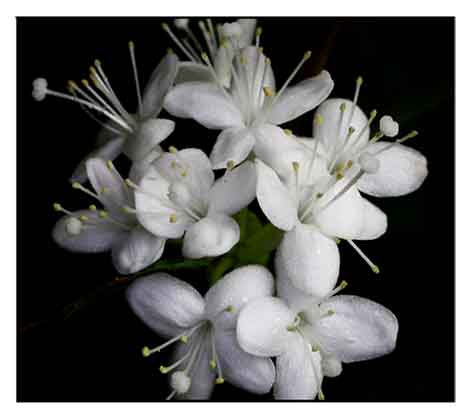 Gen info Gen info
- Phaleria is a genus of flowering plants in the family Thymelaeaceae, consisting of about 20-25 families.
Botany
Phaleria capitata is a shrub or small tree, up to 9 m tall with trunk up to 16 cm in diameter. Leaves decussate or opposite; petiole 5 mm long; blade elliptic-oblong, (11-) 15-21 (-26) cm × (3.5-) 5.5-7 (-10) cm, base acute to attenuate, apex narrowly acute to acuminate, with 8-10 pairs of veins. Inflorescence usually terminal, sometimes in leaf axils of terminal node, solitary, cauliflorous, subsessile or with about 3 cm long peduncle, usually 8-flowered; flowers bisexual, 2.5-4.5 cm long, sessile; calyx lobes oblong to elliptical, 6-7 mm × 2-3.5 mm; corolla tube cylindrical, white, gradually enlarged towards the top; stamens and style exserted up to 5 mm; ovary ellipsoid, glabrous, stigma capitate, 1.5 mm × 1 mm. Fruit drupaceous, 1- to 2-seeded. Seed subglobose or slightly ovate, about 1.5 cm × 1.3 mm.Â
 Distribution Distribution
- Native to the Philippines.
- Also native to Borneo, Caroline Is., Jawa, Maluku, New Guinea, Sri Lanka, Sulawesi, Sumatera.
- In primary and secondary forests up to 1200 m altitude.
- Ornamental cultivation.
Constituents
- Activity-guided fractioination of leaf extract isolated a mixture of acylglucosylsterols (1 ) as active constituent along with inactive constituents, tetracosanol and mangiferin. Compound 1 was deduced to be a mixture of known 3-O-(6-O-acyl-beta-D-glucosyl)-beta-sitosterols, the acyl moiety being palmitoyl (57%), oleoyl (12%) and alpha-linolenoyl (12%) with small amounts of stearoyl (7%) and linoleoyl (4%). (see study below) (3)
- Activity-guided fractionation of Onagael by α-glucosidase inhibition assay led to isolated of known xanthone C-glycoside, mangiferin, as an active constituent. HPLC analysis in 50% ethanolic, methanolic, and aqueous extracts of Ongael were 23.6%, 42.2%, and 19.9%, respectively. (see study below) (5)
Properties
- Studies have suggested immunopotentiatory, anti-inflammatory, antidiabetic, immunostimulatory, antitumor properties.
 Toxicity concerns Toxicity concerns
- Seed cotyledons reported to contain a biting poison.
Parts used
Seeds, leaves.
Uses
Edibility
- Fruits are edible, sweet.
Folkloric
- No reported folkloric medicinal use in the Philippines.
-
In Java, seeds applied externally against scurf in children.
Others
- Fiber: In the Philippines and Indonesia, tough fiver use for tying material and making cordage.
- Resin: Wood resin used in making joss (incense) sticks and crafts.
Studies
• Immunopotentiatory Activity / Leaves: Study evaluated the effect of 'Ongael' (leaves of Phaleria cumingii) on immunosuppressive diabetic mice. Oral administration of 50% ethanolic extract (ONG-ext 500 ,mg/kg) on Ongael significantly increased the production of interferon (IFN)-γ. Mangiferin (100 mg/kg p.o.), a major constituent of ONG-est, significantly enhanced secretion of IFN-γ, TNF-α, and interleukin (IL)-2. Results suggest Ongael acts as immunopotentiator to immunoincompetence in diabetes mellitus. (2)
• Anti-Inflammatory / Leaves: Extract of Ongael (leaves of Phaleria cumingii) enhanced invitro phagocytic activity of mouse macrophages RAW 264.7 cells. Activity-guided fractioination isolated a mixture of acylglucosylsterols (1 ) as active constituent along with inactive constituents, tetracosanol and mangiferin. (see constituents above) (3)
• Antitumor / Mangiferin / Immunostimulatory / Leaves: A 50% ethanolic extract (ONG-ext) of leaves of Phaleria cumingii inhibited proliferation of mice mammary carcinoma cells (MM46) and human leukemia cells (HL60) at concentration of 50 to 200 µg/ml. Mangiferin (1), a major constituent, showed antiproliferative activities on MM46 and HL60 cells at concentration of 100 µg/ml. The ONG-ext and mangiferin significantly inhibited the reduction of tumor necrosis factor alpha (TNF-α) and interleukin 2 (IL-2) levels, and ONF-ext and 500 mg/kg P.O. increased IFN-α level. ONG-G and acylglucosylsterol (2) significantly increased both TNF-α and IFN-γ levels. Results suggest the invivo antitumor effect of ONG-ext partly depends on immunostimulatory activity and the active constituents (1,2). (4)
• Antidiabetic / Leaves: A 50% ethanolic extract of Ongael leaves showed remarkable decrease in blood glucose level on make KK-Ay mice and sucrose loading test in male ddY mice. Activity-guided fractionation of Onagael by α-glucosidase inhibition assay led to isolated of known xanthone C-glycoside, mangiferin, as an active constituent. HPLC analysis in 50% ethanolic, methanolic, and aqueous extracts of Ongael were 23.6%, 42.2%, and 19.9%, respectively. (5)
Availability
Wild-crafted.
Ornamental cultivation.
|

![]()






